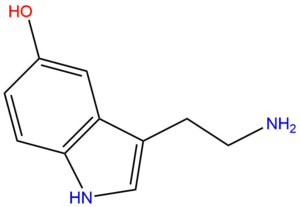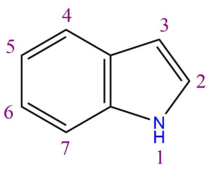Serotonin: Difference between revisions
>Kaylee m Text replacement - " drugs " to " substances " |
>Kaylee m Text replacement - " drug " to " substance " |
||
| Line 18: | Line 18: | ||
A few psychedelic substances are full agonists of the 5-HT<sub>2A</sub> receptor; among them are [[25I-NBOMe]] and [[Bromo-DragonFLY]]. | A few psychedelic substances are full agonists of the 5-HT<sub>2A</sub> receptor; among them are [[25I-NBOMe]] and [[Bromo-DragonFLY]]. | ||
====Partial agonists==== | ====Partial agonists==== | ||
A serotonin [[Agonist#Agonists|partial agonist]] is a | A serotonin [[Agonist#Agonists|partial agonist]] is a substance that binds to and activates a serotonin receptor, but only has partial efficacy at the receptor relative to a full agonist. | ||
Most classical psychedelic substances are partial agonists of the 5-HT<sub>2A</sub> receptor; among them are [[LSD]], [[psilocin]] and [[mescaline]]. Many antidepressants, anxiolytics/anti-anxiety drugs, and cluster headache medicines are partial serotonin receptor agonists. | Most classical psychedelic substances are partial agonists of the 5-HT<sub>2A</sub> receptor; among them are [[LSD]], [[psilocin]] and [[mescaline]]. Many antidepressants, anxiolytics/anti-anxiety drugs, and cluster headache medicines are partial serotonin receptor agonists. | ||
| Line 28: | Line 28: | ||
====Releasing agents==== | ====Releasing agents==== | ||
A serotonin [[Releasing Agent|releasing agent]] is a | A serotonin [[Releasing Agent|releasing agent]] is a substance that induces the release of serotonin from the presynaptic neuron into the synapse, leading to an increase in the extracellular concentrations of serotonin. | ||
Many recreational substances are serotonin releasing agents; among them are [[MDMA]], [[MDA]] and [[mephedrone]]. Many analgesics/pain-relievers and appetite suppressants are also serotonin releasing agents. | Many recreational substances are serotonin releasing agents; among them are [[MDMA]], [[MDA]] and [[mephedrone]]. Many analgesics/pain-relievers and appetite suppressants are also serotonin releasing agents. | ||
| Line 38: | Line 38: | ||
====Antagonists==== | ====Antagonists==== | ||
A serotonin receptor [[antagonist]] is a type of receptor | A serotonin receptor [[antagonist]] is a type of receptor substance that inhibits action at serotonin receptors. | ||
Many [[anti-psychotics]] and anti-emetics are serotonin receptor antagonists. One example is galanolactone, a chemical found in ginger, that acts as an anti-emetic via its action as a 5-HT<sub>3</sub> antagonist. | Many [[anti-psychotics]] and anti-emetics are serotonin receptor antagonists. One example is galanolactone, a chemical found in ginger, that acts as an anti-emetic via its action as a 5-HT<sub>3</sub> antagonist. | ||
| Line 45: | Line 45: | ||
''Main Article: [[Serotonin Syndrome|Serotonin Syndrome]]'' | ''Main Article: [[Serotonin Syndrome|Serotonin Syndrome]]'' | ||
Extremely high levels of serotonin can cause a condition known as serotonin syndrome that has toxic and potentially fatal effects. Serotonin syndrome, also known as serotonin toxicity, can be induced via overdose of particular drugs, | Extremely high levels of serotonin can cause a condition known as serotonin syndrome that has toxic and potentially fatal effects. Serotonin syndrome, also known as serotonin toxicity, can be induced via overdose of particular drugs, substance interactions, and recreational substance use. Many substance interactions have been found to cause serotonin syndrome, the most notorious of which being the combination of an SSRI antidepressant and an [[MAOI]] antidepressant. | ||
Symptoms can start showing within minutes and can include increased heart rate, sweating, anxiety, hyperthermia, shivering, high blood pressure, agitation, seizures, and rarely death. Symptoms usually resolve after 24 hours, but can last up to several months in some cases. | Symptoms can start showing within minutes and can include increased heart rate, sweating, anxiety, hyperthermia, shivering, high blood pressure, agitation, seizures, and rarely death. Symptoms usually resolve after 24 hours, but can last up to several months in some cases. | ||
Revision as of 05:44, 28 January 2017

Serotonin, also known as 5-hydroxytryptamine (5-HT), is a monoamine neurotransmitter affecting the serotonin receptors (5-HT1-7). Serotonin is primarily found in the gastrointestinal tract, platelets, and in the central nervous system of animals including humans. It is popularly thought to be a contributor to feelings of well-being and happiness.
Approximately 90% of the human body's total serotonin is located in the digestive system, where it is used to regulate intestinal movements. The remainder is synthesized in serotonergic neurones of the CNS, where it has various functions. These include the regulation of mood, appetite, and sleep. Serotonin also has some cognitive functions, including memory and learning. In the blood, it serves as a vasoconstrictor, and could be attributed as the cause of vasoconstriction in most serotonergic drugs.
Chemistry


Serotonin is comprised of a monoamine chain attached to an indole ring at the third carbon. A monoamine chain is made up of an amine group attached to an ethane chain. This monoamine chain can be found in many neurotransmitters, including histamine, dopamine, adrenaline and noradrenaline. It's also found in many drugs, examples being tryptamines and phenethylamines.
The 5-HT system
The 5-HT receptors, or serotonin receptors, are found in the central nervous system and the peripheral nervous system. They exhibit both excitatory and inhibitory neurotransmission.
Drugs targeting the 5-HT system
Full agonists
A serotonin full agonist is a chemical that binds to and activates a serotonin receptor and triggers a response, displaying full efficacy at that receptor.
A few psychedelic substances are full agonists of the 5-HT2A receptor; among them are 25I-NBOMe and Bromo-DragonFLY.
Partial agonists
A serotonin partial agonist is a substance that binds to and activates a serotonin receptor, but only has partial efficacy at the receptor relative to a full agonist.
Most classical psychedelic substances are partial agonists of the 5-HT2A receptor; among them are LSD, psilocin and mescaline. Many antidepressants, anxiolytics/anti-anxiety drugs, and cluster headache medicines are partial serotonin receptor agonists.
Inverse agonists
A serotonin inverse agonist activates a serotonin receptor but has the opposite pharmacological effect. Inverse agonists trigger a specific response from a receptor, whereas antagonists inhibit the activity of the receptor.
Some antipsychotics such as pimavanserin are 5-HT2A inverse agonists. 5-HT2A inverse agonists have been researched for the treatment of insomnia with limited success.
Releasing agents
A serotonin releasing agent is a substance that induces the release of serotonin from the presynaptic neuron into the synapse, leading to an increase in the extracellular concentrations of serotonin.
Many recreational substances are serotonin releasing agents; among them are MDMA, MDA and mephedrone. Many analgesics/pain-relievers and appetite suppressants are also serotonin releasing agents.
Reuptake inhibitor
A serotonin reuptake inhibitor inhibits the reabsorption of serotonin into the pre-synaptic neuron. Serotonin reuptake inhibitors do this by inhibiting the serotonin transporter, or SERT protein.
Many antidepressants such as venlafaxine (Effexor), citalopram (Celexa) and amitriptyline are serotonin reuptake inhibitors. Many recreational substances like cocaine and tramadol are also serotonin reuptake inhibitors.
Antagonists
A serotonin receptor antagonist is a type of receptor substance that inhibits action at serotonin receptors.
Many anti-psychotics and anti-emetics are serotonin receptor antagonists. One example is galanolactone, a chemical found in ginger, that acts as an anti-emetic via its action as a 5-HT3 antagonist.
Serotonin syndrome
Main Article: Serotonin Syndrome
Extremely high levels of serotonin can cause a condition known as serotonin syndrome that has toxic and potentially fatal effects. Serotonin syndrome, also known as serotonin toxicity, can be induced via overdose of particular drugs, substance interactions, and recreational substance use. Many substance interactions have been found to cause serotonin syndrome, the most notorious of which being the combination of an SSRI antidepressant and an MAOI antidepressant.
Symptoms can start showing within minutes and can include increased heart rate, sweating, anxiety, hyperthermia, shivering, high blood pressure, agitation, seizures, and rarely death. Symptoms usually resolve after 24 hours, but can last up to several months in some cases.
See also
References
 |
This article does not cite enough references. You can help by adding some. |